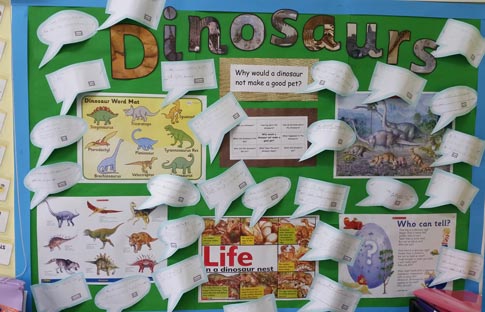Reverse Genetic Engineering to Produce a Dinosaur Snout
A team of scientists based in the United States have tweaked the developmental processes that take place in chicken embryos to re-engineer the snouts of their dinosaur ancestors. The research team led by University of Yale palaeontologist, Bhart-Anjan S. Bhullar and developmental biologist Arhat Abzhanov (Harvard University), have produced the first bird embryos that possess a snout similar to a dinosaur’s nose rather than a beak. The chicken embryos developed palatial bones and a jaw configuration that resembles that seen in the fossil record, specifically in the Dromaeosauridae, a group of dinosaurs that are closely related to modern Aves.
Bird Embryos Possess a Snout Similar to a Dinosaur Snout
The dromaeosaurs, sometimes referred to as the “raptors” belong to the Suborder Theropoda. They are part of a clade of agile dinosaurs that reduced their tails, lost their teeth and evolved into Aves (birds). Typical dromaeosaurids are Velociraptor, Deinonychus and the recently named Saurornitholestes sullivani.
To read an article about the newly described Saurornitholestes sullivani: Sniffing Out a New Dinosaur Species.
As the Yale University press release states: “Just don’t call them Dino-chickens!”
Tweaking the Beak from Dromaeosaurs to Modern Birds
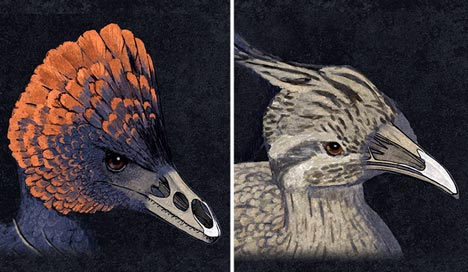
From the Dinosauria (left) to the beaks of modern Aves (right).
Picture credit: John Conway
Manipulating Chicken Embryos
The scientists were not in the business of trying to create a living dinosaur. Manipulation of chicken embryos has taken place for several years, all part of research to help the understanding of how molecular processes affect the development of organisms.
Commenting on this research, which has just been published in the journal “Evolution”, lead author Dr Bhart-Anjan S. Bhullar (Department of Organismic and Evolutionary Biology, Yale) stated:
“Our goal here was to understand the molecular underpinnings of an important evolutionary transition, not to create a “dino-chicken” simply for the sake of it.”
Researching Cranial Development
For the young doctor, this is all part of his on-going research into cranial development in very young animals. It is not part of a concerted effort to bring back the Dinosauria, a sort of “Jurassic Park from the embryo upwards”, as explained by a spokesperson from Everything Dinosaur.
There are a huge variety of bird beaks, from the curved, tearing and cutting beaks of eagles, to the sophisticated sieves of flamingos. The beak is an essential component of avian anatomy and the researchers are trying to unravel how the beak evolved from its reptilian ancestry. A quantitative analysis of fossils closely associated with the origins of birds was undertaken along with a study of extant animals including lizards, crocodiles and birds.
How the Beak of Birds Evolved
This examination allowed the scientists to develop a hypothesis as to how the bird beak may have evolved from the Dinosauria and the developmental stages that were involved.
The team identified that both major living lineages of birds, the abundant Neognathae (which includes virtually all species of extant birds) and the much rarer Palaeognathae (which comprises the Tinamou family of birds from South and Central America plus the flightless ratites – cassowary, ostrich, kiwi, rhea, for example), differ from reptiles that are not closely related to birds and from mammals in that they have a unique, median gene expression zone of two different facial development genes early in embryonic development. This median gene expression had previously only been identified in chicken embryos.
Turning Back the Evolutionary Clock
In order to have an embryo revert to its ancestral state, before the beak as it were, the gene expression for beak formation in the young chicken had to be turned off. Microscopic beads coated in a molecule inhibiting substance were used to inhibit the activity of the proteins produced by the bird specific, median signalling zone in the chicken embryos. This led the embryo to revert back to its reptilian ancestry with a more dinosaur-like snout forming and surprisingly, the palatine bone in the root of the mouth was also altered.
Changing the Faces of Embryos (Modified Chicken Embryo with Snout)
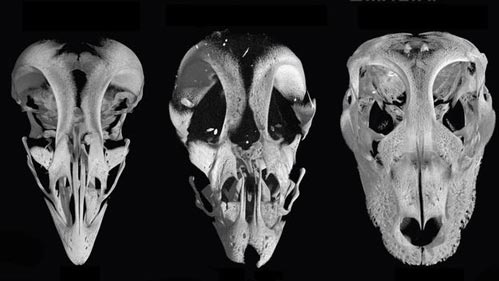
Normal chick (left), modified chicken embryo (centre), alligator embryo (right)
Picture credit: Evolution
Unexpected Changes
Dr Bhullar was surprised by the additional changes seen in the palatine bone, he stated:
“This was unexpected and demonstrates the way in which a single, simple developmental mechanism can have wide-ranging and unexpected effects.”
Commenting on the research, Professor Michael Benton (Bristol University), someone who knows a great deal about bird evolution, explained that this new study shows that the beak of birds develops very different from the snouts, noses and jaws of reptiles. A different set of genes are involved.
He stated:
“That’s what proves the beak is a real adaptation or “thing”, not just a slightly different nose shape”
Why Dinosaur Snouts and Bird Beaks?
Intriguingly, although the fossil record for bird evolution is far from complete, the fantastically well preserved bird fossils of Lower Cretaceous deposits from China, specimens of Confuciusornis for instance, show that by around 125 million years ago the toothless beak had evolved.
Why the beak came about remains a point of significant debate, however, one of the most often cited reasons for a lighter, toothless structure is that as birds became more efficient fliers and spent more time in the air, the loss of a heavy, bony jaw lined with teeth was just one of a number of anatomical adaptations that occurred to help improve powered flight.
A Model of the “Early Bird” Confuciusornis sanctus from China
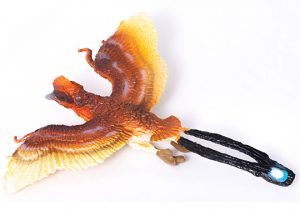
Confuciusornis model (PNSO Age of Dinosaurs).
Picture credit: Everything Dinosaur
The picture (above), depicts the PNSO Confuciusornis replica. There are a number of feathered prehistoric animal models in the PNSO range: PNSO Age of Dinosaurs.
Important Implications
The American based researchers are confident that their work has important implications for other geneticists and for palaeontologists. For example, if a single molecular mechanism was responsible for this transformation, there should be a corresponding, linked transformation in the fossil record. The flightless, man-sized Hesperornis, a genus of prehistoric bird known from the Late Cretaceous of North America could demonstrate that link.
An Illustration of Hesperornis (Traditional View)
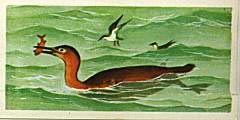
Hesperornis catching a fish.
Picture credit: Everything Dinosaur/Brooke Bond
Dr Bhullar said:
“This is borne out by the fact that Hesperornis, discovered by Othniel Charles Marsh of the Yale Peabody Museum of Natural History, which is a near relative of modern birds that still retains teeth and the most primitive stem avian with a modern-looking beak in the form of a fused, elongate premaxillae, also possesses a modern bird palatine bone.”
The premaxillae are the bones that form the tip of the upper jaw (anterior portion) of most animals, but are enlarged and fused to form the beak of birds.
Finding a Hypothetical Developmental Path
Moving forward, the quantitative analysis to establish a proposed hypothetical developmental path of a lineage of animals which could be tested by inhibiting the behaviour of proteins in embryos can be probably be used to investigate a wide range of underlying developmental mechanisms in organisms.
The dinosaur/bird link is now well established, a theory once proposed by the likes of Henry Govier Seeley back in the 1880’s is widely accepted. Back in 2013, Everything Dinosaur reported on research from an international team of scientists, including researchers from the Royal Veterinary College (London), that looked at how the posture of birds was derived from the gait of small, cursorial dinosaurs.
To read more about this study: The Birds Have the Dinosaurs to Thank for their Crouching Gait.
Everything Dinosaur notes the support of Yale University in the compilation of this article.


